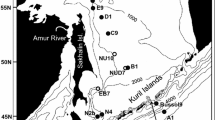Abstract
Population dynamics and production of the calanoid copepodParacalanus sp. were studied from November 1986 to November 1987 in Fukuyama Harbor, a eutrophic inlet of the Inland Sea of Japan. This species was perennial, with a large abundance peak in June/July and small peaks in September/October and November/December. During a year of investigation, 15 generations Gould be detected. For each generation, the mean population egg production rate and the mean daily midstage abundance front NIII to CV were determined to obtain a survival curve from egg to CV. The mortality was extremely high during the early life stages: on average only 7.1% of the eggs produced might survive into NIII. This high mortality might be caused by predation by sympatric omnivorous copepods, in addition to sinking loss of eggs from the waten column. The biomass ofParacalanus sp. showed marked seasonal variations largely in parallel with numerical abundance. The instantaneous growth rate of each developmental stage increased exponentially with temperature up to 20 °C, above which the rate was constant. The annual integrated production rate was 734 mg C m−3 yr−1 or 5.5 g C m−2 yr−1.
Similar content being viewed by others
References
Checkley DM Jr (1980a) The egg production of a marine planktonic copepod in relation to its food supply: laboratory studies. Limnol Oceanogr 25: 430–446
Checkley DM Jr (1980b) Food limitation of egg production by a marine, planktonic copepod in the sea of southern California. Limnol Oceanogr 25: 991–998
Edmondson WT, Comita GW, Anderson GC (1962) Reproductive rate of copepods in nature and its relation to phytoplankton populations. Ecology 43: 625–634
Fager EW (1973) Estimation of mortality coefficient from field samples of zooplankton. Limnol Oceanogr 18: 297–301
Hirota R (1962) Species composition and seasonal changes of copepod fauna in the vicinity of Mukaishima. J oceanogr Soc Japan 18: 35–40
Hirota R (1964) Zooplankton investigations in Hiuchi-nada in the Setonaikai (Inland Sea of Japan). I. The seasonal occurrence of copepods at the three stations in Hiuchi-nada. J oceanogr Soc Japan 20: 24–31
Hirota R (1979) Seasonal occurrence of zooplankton at a definite station off Mukaishima from July of 1976 to June 1977. Publs Amakusa mat biol Lab 5: 9–17
Huntley M, Boyd C (1984) Food-limited growth of marine zooplankton. Am Nat 124: 455–1178
Huntley M, Lopez MDG (1992) Temperature-dependent production of marine copepods: a global synthesis. Am Nat 140: 201–242
Ianora A, Mazzocchi MG, Scotto di Carlo B (1987) Impact of parasitism and intersexuality on Mediterranean populations ofParacalanus parvus (Copepoda: Calanoida). Dis aquat Org 3: 29–36
Ianora A, Scotto di Carlo B, Mazzocchi MG, Mascellaro P (1990) Histomorphological changes in the reproductive condition of parasitized marine planktonic copepods. J Plankton Res 12: 249–258
Kiørboe T, Mohlenberg F, Tiselius P (1988) Propagation of planktonic copepods: production and mortality of eggs. Hydrobiologia 167/168: 219–225
Liang D, Uye S (1996) Population dynamics and production of the planktonic copepods in a eutrophic inlet of the Inland Sea of Japan. II.Acartia omorü. Mar Biol 125: 109–117
Liang D, Uye S (in preparation) Population dynamics and production of the planktonic copepods in a eutrophic inlet of the Inland Sea of Japan. IV.Pseudodiaptomus nnarinus. Mar Biol
Liang D, Uye S, Onbé T (1994) Production and loss of eggs in the calanoid copepodCentropages abdominalis Sato in Fukuyama Harbor, the Inland Sea of Japan. Bull Plankton Soc Japan 41: 131–142
Liang D, Uye A, Onbé T (1996) Population dynamics and production of the planktonic copepods in a eutrophic inlet of the Inland Sea of Japan. I.Centropages abdominalis. Mar Biol 124: 527–536
McLaren MR (1978) Generation lengths of some temperate marine copepods: estimation, prediction, and implications. J Fish Res Bd Can 35: 1330–1342
Uye S (1991) Temperature-dependent development and growth of the planktonic copepodParacalanus sp. in the laboratory. Bull Plankton Soc Japan (Spec Vol): 627–636
Uye S, Kuwata H, Endo T (1986) Standing stocks and production rates of phytoplankton and planktonic copepods in the Inland Sea of Japan. J oceanogr Soc Japan 42: 421–434
Uye S, Shibuno N (1992) Reproductive biology of the planktonic copepodParacalanus sp. in the Inland Sea of Japan. J Plankton Res 14: 343–358
Yamazi I (1956) Plankton investigations in inlet waters along the toast of Japan. XIX. Regional characteristics and classification of inlet waters based on the plankton communities. Publ Seto mar biol Lab 5: 157–196
Author information
Authors and Affiliations
Additional information
Communicated by T. Ikeda, Hakodate
Rights and permissions
About this article
Cite this article
Liang, D., Uye, S. Population dynamics and production of the planktonic copepods in a eutrophic inlet of the Inland Sea of Japan. III.Paracalanus sp.. Mar. Biol. 127, 219–227 (1996). https://doi.org/10.1007/BF00942106
Received:
Accepted:
Issue Date:
DOI: https://doi.org/10.1007/BF00942106



